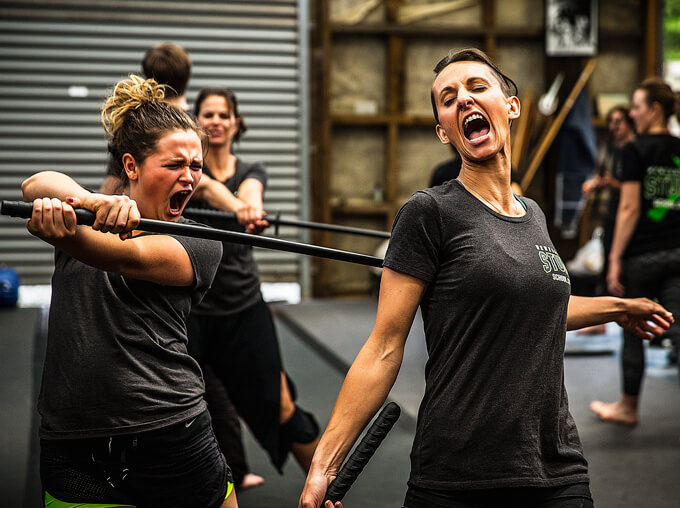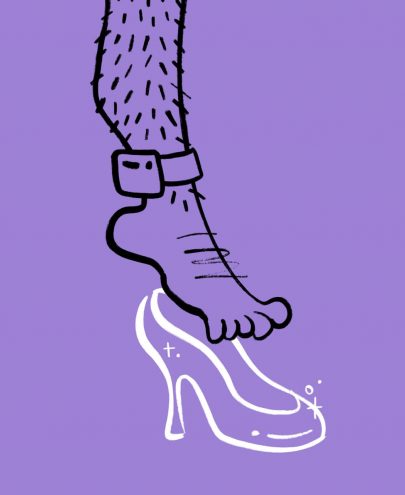Feb 2, 2017 etc
Send a writer who has never even touched a horse to learn tricks on one at the country’s only professional stunt school? Hey, why not?
Christ, it’s humiliating. Everyone has just seen me fail to do the most basic of backflips in a harness. And now I’m crying like I’m six years old again and mum won’t let me watch Hercules because I ate my brother’s iced bun. I’m about to regress to full, thumb-sucking gibberish in front of New Zealand’s hardest badasses.
“Are you okay?” “Do you need to get down?” “Are your legs hurting?” The stunt performers rush in, full of sympathy. They’re so nice it makes my nose sting. It takes me a moment to realise this is not pity, it’s just a lifetime of having been there, done that. They’ve all been injured, broken, failed in front of their colleagues.
Even today, at their usual three-hour Sunday afternoon training session, we’d already had an accident. Someone injured their ankle doing a tumble and the other stunties had to crowd in with the Wattie’s frozen spinach. Even Dayna Grant, the boss of the New Zealand Stunt School in Karaka, has had epic accidents. She once fell while doing a double-dagger fight on a film set; a dagger flipped up, went through her cheek and fractured the back of an eye socket. She still can’t feel that side of her face. And that’s not even as bad as it gets. The stunties all know of other performers who have ended up in wheelchairs. Or dead.
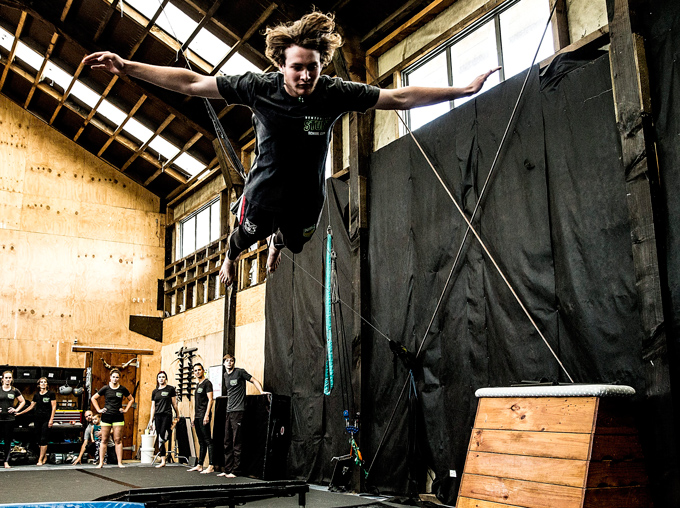
This point, the point when you’re sobbing and humiliated, is the first test of being a stunt performer. What do you do when you’re in so much pain it feels like someone has pulled out your vertebrae with rusty pliers? Normal people say, “Fuck this. I’m stopping. I need to drink a whisky and cry in the bath.” Stunt performers say, “Yep. All good. Let’s go again.”
“Let’s go again,” I choke, wiping away unidentifiable goo on my face, “all good.” Jade, the elastic-boned brunette who’s “spotting” me, looks at me with professional sympathy. “It’s okay,” she explains. “You’ve just got to remember to tuck up your knees when you’re throwing yourself backwards. Then your legs follow over your head. And commit! Don’t panic halfway through or that’ll happen again!”
I take a breath. Okay, so I haven’t done any physical exercise since PE in Year 7. But this had looked like so much fun — who doesn’t want to fly around the ceiling on a wire? It’s not fun. The harness ensnares your lady parts like a particularly vindictive python. “It’ll be fine,” says Jade. “After a while, it goes numb.” I nod. It’s not numb. It feels like something large and fanged is biting my vagina.
I start to bounce and the bungee winches me into the air. Bounce. Ow. Bounce. Owwwwww. Bounce… Jesus Christ. Owwwww… Bounce! Up! Back! Tuck! Flip!
They all cheer as I make it through the tumble. This is a basic flip, the finger painting of aerial tricks, but I did it. “Yeaaaaaahhhh!” screams my brain, “I’m a ninja!” It’s divine, reckless ecstasy.
This wasn’t the first time I failed, cried and eventually succeeded over the two weekends I went to stunt school. The second weekend was a workshop where I rode a rearing horse, having never as much as touched a horse before. Rory, the horse expert, instructed me, “Do not lean back when it’s rearing!” So naturally when it reared, I leant back. I stayed on only by jamming my feet in at the last second. But my head and spine snapped back like a broken rubber band over the horse’s arse. Eventually, on my fifth attempt, the horse exploded beneath me like a geyser and my body flew backwards but I threw myself forward into its neck and hung there until the eruption passed. Success. They had to peel me off but I did it.
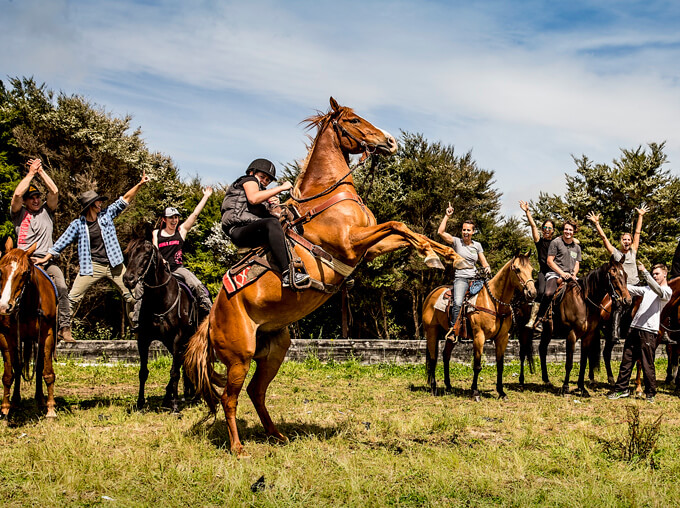
The school is the only stunt training place in the country. You’ve probably never heard of it. And you’ve probably never heard of Grant, the woman behind it. But you will have seen her. Have you seen Mad Max: Fury Road? In it, Furiosa, the lead character played by Charlize Theron, spends 90 per cent of her time sliding under trucks, driving flaming cars and brandishing machine guns. Well, it wasn’t Charlize doing that stuff, it was Grant, Charlize’s double. She spent nine months in the Namibian desert learning to strip and reassemble machine guns blindfolded and jumping off tanks.
Grant gets flown around the world to double for stars like Theron, Gwyneth Paltrow and Tilda Swinton. And she lives in Karaka. On a farm. With a pet pig. And she came from a job making “truly awful” coffee in a cafe, to her first-ever stunt job as Lucy Lawless’ double, to being in the top five stunt performers in the world.
Fellow professional stunt performer Zokir (Zach) Sultanov introduced her to me as “the top female stuntie in the world right now”. You get the feeling that if he says Grant is good, then she’s the absolute fucking best. Sultanov grew up riding horses for the Taliban through the poppy fields of Uzbekistan — as you do. He was with the Great Moscow Circus for 20 years, and eventually came to New Zealand, establishing himself as a legend among stuntmen. He’s pulled in for big-budget Hollywood movies such as Crouching Tiger, Hidden Dragon. He also lives in Karaka. (I didn’t ask if he had a pig.)
Grant even looks like an Amazonian warrior queen. One of those women who back in the day would have led armadas and collected the skulls of her conquests. She’s the sort of woman who could break your face and you’d love it.
Dayna Grant and husband Dane run the stunt school. (The name thing is cute. What’s cuter is that they met on the set of Mad Max as the doubles for the two leads).
Grant grew up on a farm and started riding at six months old. “My dad picked me up and tied me to the saddle.” The stunt school looks like a farm that was built by ninjas. Training takes place in a converted barn lined with trampolines, ropes, mats, swords, gymnastic vaults, bungees, and scaffolding for high falls.
Over the two weekends, they took me through their standard training session and then the workshop for horse-riding stunts. The weekly Sunday session is where new stunties refine their tricks and the experienced ones stay fit for duty. It’s a mixture of gymnastics, basic falls and weapons training. There are also workshops on specialist skills — how to set yourself on fire, how to fall off a building, that sort of thing — open to anyone who has done an introductory course on fighting for camera. After that, you can join weekly training, do workshops and start nabbing jobs.
When you lay it all out like this, it sounds like anyone can be a stunt performer. Anyone who has ever watched James Bond has thought, “Man, that looks fun! I could do that!” And to an extent, you can just give it a go.
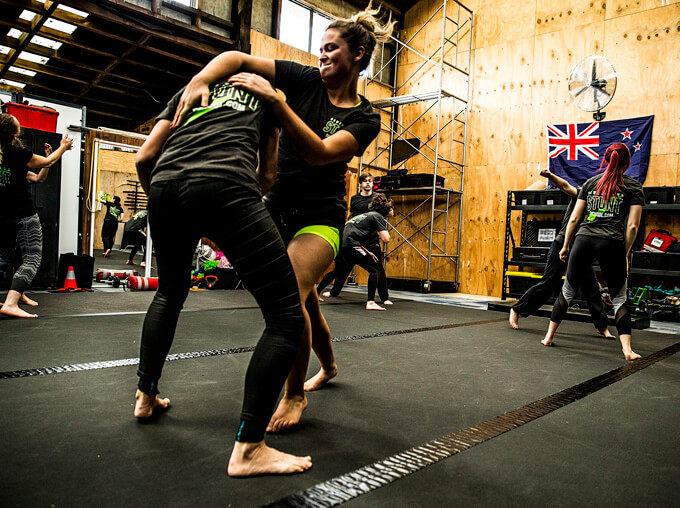
Before the stunt school opened in 2010, it was hard for new stunties to break into the industry. The movies would audition rookies and give them jobs. But this would often be their first time on set, let alone doing a stunt. They were simply trained on the job. So the new performers looked rubbish on camera in comparison to the pros, and weren’t rehired. The industry just reused the same, often bald and stubbly, blokes.
By introducing stunt training for rookies, Grant increased their chances of being hired again. The school has ushered in a more diverse generation of stunties: my training session included Briony, a 22-year-old Ernst & Young consultant; Trish, 57, a teacher who got her first stunt job at 56; and, naturally, a Jason Statham doppelgänger, Chris, 34. Some of them, like the elastic Jade, are full-time performers and some, like Briony, are juggling stunts with normal jobs.
So yes, getting into the industry is much easier now. But that doesn’t mean you’ll survive it. I started off training thinking, yeah, I could totally have a career in this! But the more I hung out at the stunt school, the more I realised that stunties are not like normal people. Making it as a proper stuntie takes a rare breed. And the longer I stayed, the more I doubted I could actually ever do this.
My theory is that stunties are actually half-stallion, half-mule. Half-stallion because they need to be fighting machines able to be tossed off buildings and land on just a few mats. They need to be able to train constantly. I asked Sultanov, who’s 50, how he stays at the top of his game. “Training,” he said. “Training and training and training.” You see the intensity of training in the speed of the Sunday sessions. We’re straight into running laps until we’re heaving, then basic gymnastics, then punching and kicking, then leaping and tumbling, sword-fighting and dagger-wielding, and finally into the harness.
And half-mule? Stunties have to wait around for hours on set without getting precious. (That’s for the actors.) And when the stunt is done, they need to be able to do it again and again and again. It doesn’t matter how much pain you’re in. You don’t stop. You don’t complain. And you do all of this knowing your scene will probably get cut.
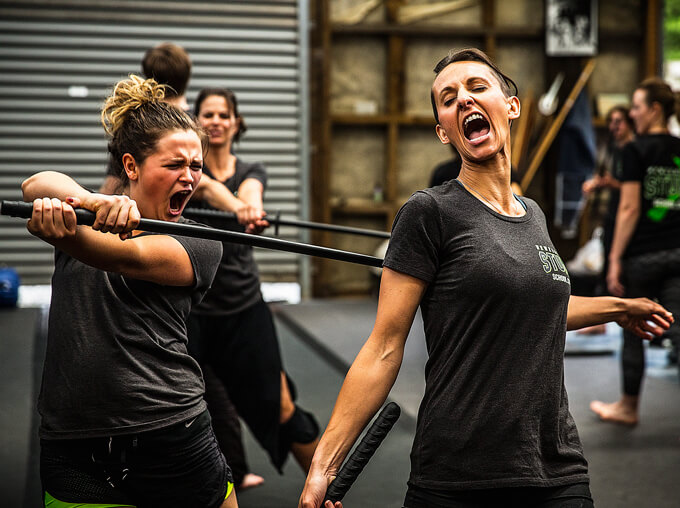
These guys know that stunt performers are in the “crew” section of the credits. Of course, a few stunties are more interested in using it as a stepping stone to acting or fame. “You do find that with younger performers,” says Grant with a frown. “They go around broadcasting that they do the stunts for so-and-so, so they should be interviewed [for acting roles].” But these guys don’t last, not in a world where everyone knows it’s their job to make someone else look good. They have to be happy in the shadows.
Veterans talk about how the call of “Okay, let’s go, guys!” is accompanied by the rattle of the pill bottle. You get pummelled, you go to bed, you wake up, you get pummelled again, you go to bed…
Yet the physicality of the work isn’t necessarily the problem. Yes, you have to keep going as it smashes the shit out of you. There were three hours of cartwheeling, jumping, kicking, punching, rolling, ducking and tumbling until I was sweating, coughing and my pinky toe was a dubious purple. I did human juggling and basic falling. And human roly-polys. I fell on my neck doing those and Grant rocked me like a baby while I bawled. It’s brutal.
But in the final 15 minutes, we choreographed a fight scene. Up came the adrenaline, down came the pain levels. Left hook! Right hook! Swing! Duck! Knee them in the stomach! Throw them on the ground! You’re James Bond! You’re Lara Croft! You can fight the whole fucking world! No amount of pain matters.
All it takes to do this is an adventurous soul and a dose of stoicism. That’s the easy part about being a stuntie. But just because you can do this, it doesn’t mean that you can really make it. The more you learn, the more you realise how superhuman you have to be.
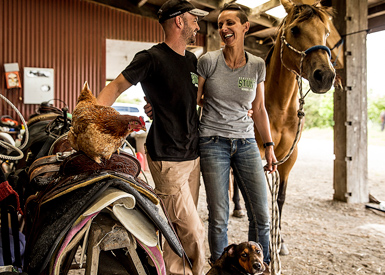
It was chatting to Dane that made me realise just how much mental control the job requires. He was rubbing the nose of a horse. “Somebody once said that stunts is an industry where if you’re holding the end of a 30-metre rope and the guy on the end of the rope is screwing your wife, you still have to hold the rope.” He mentioned that both he and Dayna had worked with her ex, also a stuntman. It was fine. You just did it. And it was then I realised that in this game, lives depend on your ability to keep emotions separate from the job. “I’ve had guys burn through thick leather gloves jumping onto ropes to save my life,” says Grant.
Not only are there horrific stories of stunties who’ve died, but they know they’re rolling the dice every time they do a job. Yet stunties seem nonchalant about death. “Yeah, maybe sometimes I think… man, what if I hurt myself?” says Grant, “but mostly you just don’t think about it.” She admits there have been times, like a scene in Mad Max when she had to slide under a truck, that had it not gone perfectly she wouldn’t have got a chance to do a retake. She’d be dead. But these guys seem okay with their daily gamble on mortality; they trust their team.
Even your team can let you down, though, leaving stunties highly vulnerable. Dane comes up to me after training; he’s shaking and holding his phone. A Bond stuntman, a veteran, has just died in a fall from a helicopter. The stuntie reportedly had safety concerns. “Even now,” says Dane, so angry he’s gone white, “even today, we speak out and we get ignored.”
The situation is disempowering at best, downright terrifying at worst. Stunties are forced to trust others with their lives, but that leaves you with a lot of people who could let you down, and a lot of horrific possibilities.
Yet here they are, working as a seamless unit. No fame whores. No thrusting egos. No “darling, adore me” moments. It’s almost unsettling how nice they are, cheering anyone who does a good stunt, rushing to support those who trip up. And they’re unnervingly calm. They have to be. You don’t want a maniac in your elaborate million-dollar motorbike-crash scene.
Seeing such minute physical and emotional control up close makes them seem almost non-human. It’s almost as though they’ve evolved beyond us normal people.
By the time I finish that training session, I’m aching in places I didn’t know I had. Only jelly snakes have the restorative power to get me off the floor. Everyone’s sharing food, inquiring after injuries and chattering excitedly about jobs. It feels like a Scout camp — if Scout camps left you unable to walk.
Afterwards, I sit in a bath full of Epsom salts for an hour, and still have to bum-shuffle up and down the stairs the next day. But still, you find yourself asking…is the pain worth it? And it is. It so is.

